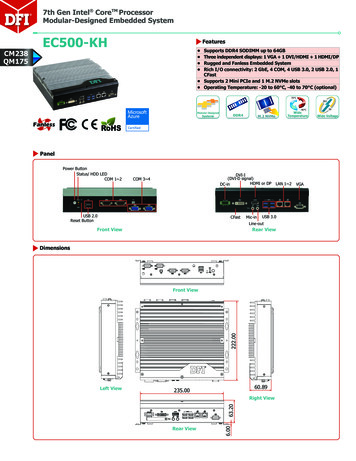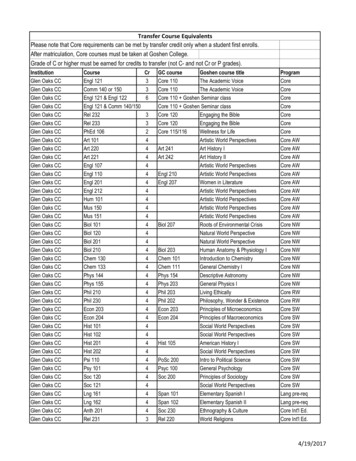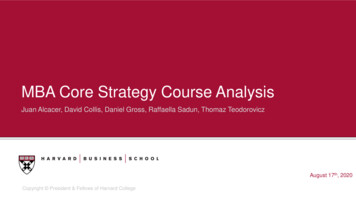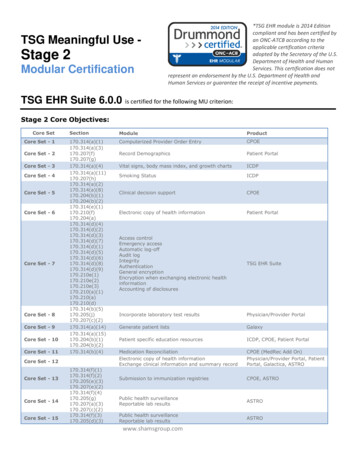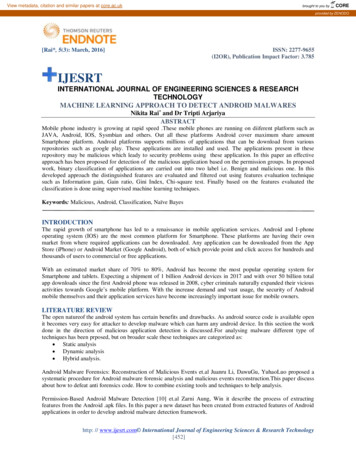
Transcription
View metadata, citation and similar papers at core.ac.ukbrought to you byCOREprovided by ZENODO[Rai*, 5(3): March, 2016]ISSN: 2277-9655(I2OR), Publication Impact Factor: 3.785IJESRTINTERNATIONAL JOURNAL OF ENGINEERING SCIENCES & RESEARCHTECHNOLOGYMACHINE LEARNING APPROACH TO DETECT ANDROID MALWARESNikita Rai* and Dr Tripti ArjariyaABSTRACTMobile phone industry is growing at rapid speed .These mobile phones are running on diiferent platform such asJAVA, Android, IOS, Sysmbian and others. Out all these platforms Android cover maximum share amountSmartphone platform. Android platforms supports millions of applications that can be download from variousrepositories such as google play. These applications are installed and used. The applications present in theserepository may be malicious which leady to security problems using these application. In this paper an effectiveapproach has been proposed for detection of the malicious application based on the permission groups. In proposedwork, binary classification of applications are carried out into two label i.e. Benign and malicious one. In thisdeveloped approach the distinguished features are evaluated and filtered out using features evaluation techniquesuch as Information gain, Gain ratio, Gini Index, Chi-square test. Finally based on the features evaluated theclassification is done using supervised machine learning techniques.Keywords: Malicious, Android, Classification, Naïve BayesINTRODUCTIONThe rapid growth of smartphone has led to a renaissance in mobile application services. Android and I-phoneoperating system (IOS) are the most common platform for Smartphone. These platforms are having their ownmarket from where required applications can be downloaded. Any application can be downloaded from the AppStore (iPhone) or Android Market (Google Android), both of which provide point and click access for hundreds andthousands of users to commercial or free applications.With an estimated market share of 70% to 80%, Android has become the most popular operating system forSmartphone and tablets. Expecting a shipment of 1 billion Android devices in 2017 and with over 50 billion totalapp downloads since the first Android phone was released in 2008, cyber criminals naturally expanded their viciousactivities towards Google’s mobile platform. With the increase demand and vast usage, the security of Androidmobile themselves and their application services have become increasingly important issue for mobile owners.LITERATURE REVIEWThe open natureof the android system has certain benefits and drawbacks. As android source code is available openit becomes very easy for attacker to develop malware which can harm any android device. In this section the workdone in the direction of malicious application detection is discussed.For analysing malware different type oftechniques has been prposed, but on broader scale these techniques are categorized as: Static analysis Dynamic analysis Hybrid analysis.Android Malware Forensics: Reconstruction of Malicious Events et.al Juanru Li, DawuGu, YuhaoLuo proposed asystematic procedure for Android malware forensic analysis and malicious events reconstruction.This paper discussabout how to defeat anti forensics code. How to combine existing tools and techniques to help analysis.Permission-Based Android Malware Detection [10] et.al Zarni Aung, Win it describe the process of extractingfeatures from the Android .apk files. In this paper a new dataset has been created from extracted features of Androidapplications in order to develop android malware detection framework.http: // www.ijesrt.com International Journal of Engineering Sciences & Research Technology[452]
[Rai*, 5(3): March, 2016]ISSN: 2277-9655(I2OR), Publication Impact Factor: 3.785Mobile-Sandbox: Having Deeper Look into Android Application et.al Michael Spreitzen barth proposed a MobileSandbox, system which is designed to automatically analyse Android applications in two novel ways. It combinesstatic and dynamic analysis, i.e., results of static analysis are used to guide dynamic analysis extend coverage ofexecuted code.It uses specie techniques to log calls to native (i.e., \non-Java") APIs.PRPOSED METHODThe process for identification of malicious android application consist of step wise approach and steps are dividedfurther into different sub tasks which includes:a) Data extractionb) Features extractionc) Features evaluationd) Classification techniquesFigure 1: Process flow for malicious application detectionA. Data Extraction:In this step the different types of APK files are extracted from different repositories. These apk files are special typeof compressed files which includes source code, manifest.xml and other resources as required by the application. Inthis step the apk files are download from Google play[], sharevirus[] for benign and malicious application.B. Feature Extraction:It is the most cruituial step for the whole process as classification depends on which features are extracted. In ourproposed work permission regading each application are considered as the features as most of the maliciousapplications uses some commom type of permission pattern which is quite different from the benign applications.The apk file is unzipped and permisiions regarding that aaplication are extracted from the manifest.xml file. For thispurpose we develop a xml parser which extract all the permmsion for every application and dataset is built.C. Feature Evaluation:The extracted features includes similar and distinguish features for type of application i.e malicious and benign. Inorder to get better classification result and accuracy there is a need of filter down this features set.Feature evaluation step find the correlation and calculated amount of information per feature. The features which hasno information value are pruned from tha dataset and new refined dataset is made. Moreover this reduced feature setreduce the overburden and provide optimizing result classification.In the prposed work recurcive feature evaluation technique and cross correlation methods are used for featureevaluation. The feature evaluation methods are implemented with the help of R statistical language.http: // www.ijesrt.com International Journal of Engineering Sciences & Research Technology[453]
[Rai*, 5(3): March, 2016]ISSN: 2277-9655(I2OR), Publication Impact Factor: 3.785D. Classification Technique:Classication techniques are machine learning techniques in which algorithm is first trained with the help of availabledataset and then it is tested in terms of correctly classification rate. These classification techniques inludes Naïvebayes, decision tree, Support vector machine and others.Naïve Bayes classification technique based on the probabilistic approach i.e. Bayes rule. Naïve Bayes is quite hoodin malicious filtering domain as there are many equally important features for different class of attributes. It is quitefast learning technique with one pass of counting over the data; testing linear in the number of attributes, anddocument collection size.Figure 2: Feature corelation matrixNaive bayes classification is based on following values:i. Prior probability: The probability that an event will reflect established beliefs about the event before the arrivalof new evidence or information. Prior probabilities are the original probabilities of an outcome, which will beupdated with new information to create posterior probabilities.ii. Posterior probability: The revised probability of an event occurring after taking into consideration newinformation. Posterior probability is normally calculated by updating the prior probability by using Bayes'theorem. In statistical terms, the posterior probability is the probability of event ‘A’ occurring given that event Bhas occurred.iii. Bayesian probability: This is based on prior and posterior probability of the events.iv. Independent events probability: The probability of two independent events is defined by the product of theirindividual probability.𝑃 (𝐴 𝐵) 𝑃(𝐴) 𝑃(𝐵) (1)v. Conditional Probability: The probability value which depends on the sequence of two events.𝑃 (𝐴 𝐵 ) 𝑃(𝐴 𝐵) (2)𝑃(𝐵)And𝑃 (𝐵 𝐴 ) 𝑃(𝐴 𝐵) (3)𝑃(𝐴)From equation 2 and 3, P (A B) P (B A).P (A).In R language the Naïve bayes technique is implemented.EXPERIMENTAL SETUPFor the classification purpose R studio[13] version 0.99.484 and Java runtime version1.8.0 31-b13 with systemconfiguration as Intel I-5 processor 3rd generation with 8 GB of RAM memory is used. R studio provide a developingenvironment for R language. R language is a collection of machine learning algorithms for data mining tasks. Theclassification algorithms can either be applied using R libraray, packages and interfaces. R languages containshttp: // www.ijesrt.com International Journal of Engineering Sciences & Research Technology[454]
[Rai*, 5(3): March, 2016]ISSN: 2277-9655(I2OR), Publication Impact Factor: 3.785packages for data pre-processing, classification, regression, clustering, association rules, and visualization. R is opensource software issued under the GNU General Public License.In experimental setup, dataset of malicious and benign android aaplications randomly divided into almost 10 sets forcross validation i.e. Dataset {D1, D2, D3, D4, D5, D6, D7, D8, D9, D10}. All the sets are mutually exclusive. Out ofthese 10 sets 9 sets at each iteration are used for training purpose i.e. Etraining and remaining set is used for testing i.e.Etesting. This process is repeated 10 times. At each iteration i.e.:Figure 3: Cross validation and ClassificationFirst iteration: {D2, D3, D4, D5, D6, D7, D8, D9, D10} for training and D1 for the testing purpose.Second iteration: {D1, D3, D4, D4, D5, D6, D7, D8, D9,D10} for training and D2 for the testing purpose. Usually 10fold cross validation results to relatively low bias and variance.Figure 4: Classification rate as per features.A. Machine Learning Techniques:C5.0: It is a classification techniques which information gain parameter for decision. The decision tree generated forthe dataset has several levels based on different features. The decision values at each level is described as in figure.http: // www.ijesrt.com International Journal of Engineering Sciences & Research Technology[455]
[Rai*, 5(3): March, 2016]ISSN: 2277-9655(I2OR), Publication Impact Factor: 3.785This classification technique is a variation of decision tree is best-known learning algorithm. C50 is re-implementedin R.This method is generally used for binary classification. Unlike nominal attributes, every attribute has manysplitting points but uses gain ratio technique for feature selection.Table Error! No text of specified style in document.1: 2X2 Confusion matrix for C50 classification techniqueConfusion MatrixActualValuesBenignMalwarePredicted ValuesBenignMalware2945166The accuracy rate for C50 is 91.47%GET ACCOUNTS.numeric 0::. ACCESS NETWORK STATE.numeric 0: Malware (6): ACCESS NETWORK STATE.numeric 0: Benign (29/3)GET ACCOUNTS.numeric 0::.SEND SMS.numeric 0: Malware (185/1)SEND SMS.numeric 0::.INSTALL PACKAGES.numeric 0: Malware (60/1)INSTALL PACKAGES.numeric 0::.CAMERA.numeric 0: Benign (7)CAMERA.numeric 0::.READ SMS.numeric 0: Malware (28/2)READ SMS.numeric 0::.CHANGE WIFI STATE.numeric 0: Malware (37/3)CHANGE WIFI STATE.numeric 0::.ACCESS COARSE LOCATION.numeric 0: Benign (9/1)ACCESS COARSE LOCATION.numeric 0::.RECEIVE BOOT COMPLETED.numeric 0: Benign (5)RECEIVE BOOT COMPLETED.numeric 0::.UPDATE APP OPS STATS.numeric 0: Benign (2)UPDATE APP OPS STATS.numeric 0::.ACCESS WIFI STATE.numeric 0: Malware (13/4)ACCESS WIFI STATE.numeric 0::.ACCESS NETWORK STATE.numeric 0: Malware (12/3)ACCESS NETWORK STATE.numeric 0: Benign (15/1)B. Random Forest:It is improved technique of decision tree. Its is an ensemble model combinethe results from differentmodels.The result from an ensemble is better than the result of individual model.In this work different classificationtechniques has been applied on the basis of results and accuracy the classification result of Random forest method isfairly good with classification accuracy as 98.31%. The absolute mean error is 0.0635.RESULT ANALYSISIt is the measure to how accurately the training model classified the test data set. This correct can be measured fourvalue i.e. TP, TN, FP, FN directly or indirectly. Random forest gives the best classification results as comparision toC50 and E1071(Naïve bayes).http: // www.ijesrt.com International Journal of Engineering Sciences & Research Technology[456]
[Rai*, 5(3): March, 2016]ISSN: 2277-9655(I2OR), Publication Impact Factor: 3.785Prevalence and Detection ced Accuracy:0.10.05C50E1071RandomForestClassification TechniqueFigure 5: Classification accuracy fordifferent classification techniques0C50E1071RandomForestClassification TechniqueFigutre6: Comparison based onPrevalence and Detection rateFinally developed approach is analysed through calculating the prevalence and detection rate. Prevelance is definedas a fraction, or a percentage or as the number of malicious application detected per 1000 dataset. The detection rateis defined as the number of malicious application detected by the system (True Positive) divided by the total numberof intrusion instances present in the dataset.CONCLUSION AND FUTURE WORKMalicious application are one the main barrier of today’s mobile security infrastructure. Malicious application is acollective term coined for all those application which are either themselves or support other aaplicationfor variousattacks. Some of the common android mobile based attacks are data leak, password theaft, malware and others.The work presented includes the comparison of different feature evaluation and classification techniques underandroid application scenario. The comparison of features evaluation is done in order to identify the minimum andoptimize set of feature vector.In classification, random forest updateable comes out with best result for multi class classification as compared toDecision tree (C50) and Naïve bayes (E1071). In this work different classification techniques has been applied onthe basis of results and accuracy the classification result of Random forest method is fairly good with classificationaccuracy as 98.31%. The absolute mean error is onal Nerurkar, “Teens drive Indian smartphone sales, study finds” phone-salesstudyfinds/articleshow/22406572.cms [Accessed : 23 Nov 2013]Cesare, x. yang and silvio, “Classification of malware using structured control flow,” Australian ComputerSociety, vol. 107, pp. 61-70, 2010.Spreitzenbarth, Michael and F. Felix, “Mobile-sandbox: having a deeper look into android applications,”Annual ACM Symposium on Applied Computing, pp. 1808-1815, 2013.“Apktool download,” [Online]. Available: code.google.com/p/android-apktool/. [Accessed 11 03 2015].Allix, kevin and q. jerome, “A Forensic Analysis of Android Malware--How is Malware Written and,”compsac, pp. 384-393, 2014.“Android malware hijacks power button,” [Online]. Available: http://www.theregister.co.uk/. [Accessed 12 52015].Machiry, Aravind and T. Rohan, “Dynodroid: An input generation system for android apps,” in Foundationsof Software Engineering, 2013.Aung, Zarni and Z. Win, “Permission-based Android malware detection,” International Journal of Scientificand Technology Research, pp. 228-234, 2013.http: // www.ijesrt.com International Journal of Engineering Sciences & Research Technology[457]
[Rai*, 5(3): March, 2016][9].[10].[11].[12].[13].[14].[15].[16].ISSN: 2277-9655(I2OR), Publication Impact Factor: 3.785Barrera, David and G. H., “A methodology for empirical analysis of permission-based security models andits,” ACM conference on Computer and communications security, pp. 73-84, 2010.Min, X. Luo and H. C. Qing, “Runtime-based behavior dynamic analysis system for android malwaredetection,” In Advanced Materials Research, vol. 756, pp. 2220-2225, 2013.M. Spreitzenbarth et Al., “Mobile-Sandbox: Having Deeper Look into Android App.”, SAC’13 March-2013,Coimbra, Portugal, pp. 18-22.Juanru Li, DawuGu and YuhaoLuo, “Android Malware Forensics Reconstruction of Malicious Events”, In32th Int. Conf. on Distributed Computing Systems Workshops 2012.Lei Cen et Al., “A Probabilistic Discriminative Model for Android Malware Detection with DecompiledSource Code”, Pub. In IEEE Trans. on dependable and secure computing, Vol.12, Issue. 04, 2015, pp. 400412.Zhang, yuan and y. min, “Permission Use Analysis for Vetting Undesirable Behaviors in Android Apps,”Information , pp. 1828-1842, 2014.Zarni Aung and Win Zaw, “A Probabilistic Discriminative Model for Android Malware Detection withDecompiled Source Code”, Int. J. of Scientific & Technology Research, Vol. 2, Issue 3, March 2013, pp.228-234.Dai-Fei Guo et Al., “Behavior classification based self-learning mobile malware detection”, Pub in J. ofComputers, Vol. 9, Issue 4, 2014, pp. 851-858.http: // www.ijesrt.com International Journal of Engineering Sciences & Research Technology[458]
Store (iPhone) or Android Market (Google Android), both of which provide point and click access for hundreds and . As android source code is available open it becomes very easy for attacker to develop malware which can harm any android device. In this section the work . Android Malware Forensics: Reconstruction of Malicious Events et.al .



